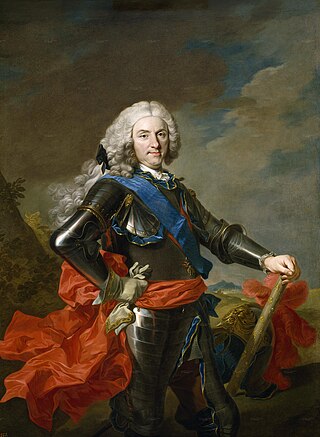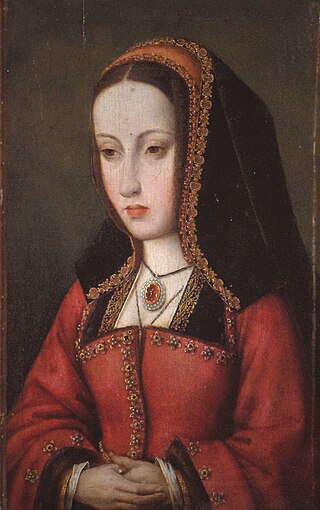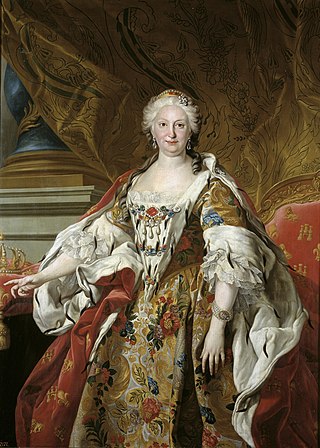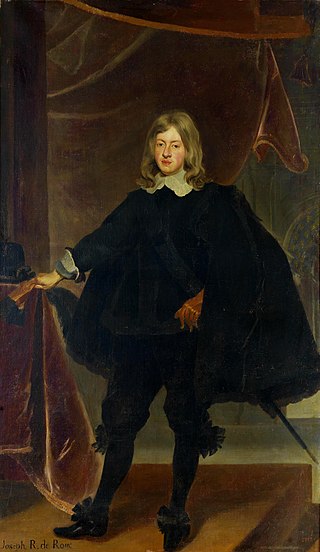Contents
| |||||
| Decades: | |||||
|---|---|---|---|---|---|
| See also: | Other events of 1746 List of years in Spain | ||||
Events from the year 1746 in Spain.
| |||||
| Decades: | |||||
|---|---|---|---|---|---|
| See also: | Other events of 1746 List of years in Spain | ||||
Events from the year 1746 in Spain.

Year 1380 (MCCCLXXX) was a leap year starting on Sunday of the Julian calendar.
The 1460s decade ran from January 1, 1460, to December 31, 1469.

1621 (MDCXXI) was a common year starting on Friday of the Gregorian calendar and a common year starting on Monday of the Julian calendar, the 1621st year of the Common Era (CE) and Anno Domini (AD) designations, the 621st year of the 2nd millennium, the 21st year of the 17th century, and the 2nd year of the 1620s decade. As of the start of 1621, the Gregorian calendar was 10 days ahead of the Julian calendar, which remained in localized use until 1923.

1746 (MDCCXLVI) was a common year starting on Saturday of the Gregorian calendar and a common year starting on Wednesday of the Julian calendar, the 1746th year of the Common Era (CE) and Anno Domini (AD) designations, the 746th year of the 2nd millennium, the 46th year of the 18th century, and the 7th year of the 1740s decade. As of the start of 1746, the Gregorian calendar was 11 days ahead of the Julian calendar, which remained in localized use until 1923.
Year 1480 (MCDLXXX) was a leap year starting on Saturday of the Julian calendar.
The 1330s was a decade of the Julian Calendar which began on January 1, 1330, and ended on December 31, 1339.

1590 (MDXC) was a common year starting on Monday of the Gregorian calendar and a common year starting on Thursday of the Julian calendar, the 1590th year of the Common Era (CE) and Anno Domini (AD) designations, the 590th year of the 2nd millennium, the 90th year of the 16th century, and the 1st year of the 1590s decade. As of the start of 1590, the Gregorian calendar was 10 days ahead of the Julian calendar, which remained in localized use until 1923.

Year 1559 (MDLIX) was a common year starting on Sunday of the Julian calendar.
Year 1452 (MCDLII) was a leap year starting on Saturday of the Julian calendar.

Philip V was King of Spain from 1 November 1700 to 14 January 1724 and again from 6 September 1724 to his death in 1746. His total reign is the longest in the history of the Spanish monarchy, surpassing Philip IV. Although his ascent to the throne precipitated the War of the Spanish Succession, Philip V instigated many important reforms in Spain, most especially the centralization of power of the monarchy and the suppression of regional privileges, via the Nueva Planta decrees, and restructuring of the administration of the Spanish Empire on the Iberian Peninsula and its overseas regions.

Ferdinand VI, called the Learned and the Just, was King of Spain from 9 July 1746 until his death in 1759. He was the third ruler of the Spanish Bourbon dynasty. He was the son of King Philip V and Queen Maria Luisa.

Ferdinand I was Holy Roman Emperor from 1556, King of Bohemia, Hungary, and Croatia from 1526, and Archduke of Austria from 1521 until his death in 1564. Before his accession as emperor, he ruled the Austrian hereditary lands of the House of Habsburg in the name of his elder brother, Charles V, Holy Roman Emperor. Also, he often served as Charles' representative in the Holy Roman Empire and developed encouraging relationships with German princes. In addition, Ferdinand also developed valuable relationships with the German banking house of Jakob Fugger and the Catalan bank, Banca Palenzuela Levi Kahana.

Joanna, historically known as Joanna the Mad, was the nominal queen of Castile from 1504 and queen of Aragon from 1516 to her death in 1555. She was the daughter of Queen Isabella I of Castile and King Ferdinand II of Aragon. Joanna was married by arrangement to the Austrian archduke Philip the Handsome on 20 October 1496. Following the deaths of her elder brother John, elder sister Isabella, and nephew Miguel between 1497 and 1500, Joanna became the heir presumptive to the crowns of Castile and Aragon. When her mother died in 1504, she became queen of Castile. Her father proclaimed himself governor and administrator of Castile.

Elisabeth Farnese was Queen of Spain by marriage to King Philip V. She was the de facto ruler of Spain from 1714 until 1746, since she managed the affairs of state with the approval of her spouse. She is particularly known for her great influence over Spain's foreign policy. From 1759 to 1760, she governed as regent.

Ferdinand IV was made and crowned King of Bohemia in 1646, King of Hungary and Croatia in 1647, and King of the Romans on 31 May 1653. He also served as Duke of Cieszyn.

Margaret of Austria was Queen of Spain and Portugal by her marriage to King Philip III & II.
Events in the year 1724 in Spain.

Events in the year 1749 in Spain.